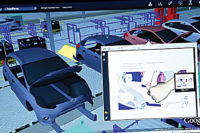Manufacturers have known the importance of being discreet since the start of the Industrial Revolution. History has definitely shown this approach to be the best way to safeguard all of a company’s technological, production and assembly secrets.
In recent years, however, manufacturers have also discovered the importance of using a discrete (different spelling) approach to design an assembly line. This approach requires that engineers view the line as a distinct series of events, each of which occurs at a particular instant in time. Between consecutive events, no change in the line is assumed to occur.
Managers at Nissan Motor Iberica SA in Barcelona, Spain, have benefitted from this approach since early 2015 with the help of discrete-event simulation software from Simio LLC. According to Jose Vilar, project manager at Nissan Europe headquarters, the software optimizes NV200 van production at the plant by using simulation to determine the most efficient layout of each assembly line.
Vilar says that Simio software was selected because of its ability to help plant managers meet three production challenges. One is monitoring various assembly lines (bodies, chassis, etc.) that converge and move at different speeds. Others are determining the exact number of vehicle carriers required to meet the plant’s projected throughput, and validating that product mixes are always correct.
The software lets Nissan engineers simulate models of current or planned assembly lines to prevent any design and performance problems. Vilar says the engineers especially like the software’s high-quality 3D graphic objects that represent real elements found on the shop floor, such as different vehicle models, carriers and monorails.
“Simio effectively complements our other engineering tools,” explains Vilar. “It easily implements logical movement and synchronizes different lines through a set of instructions. [This] expands our capability to solve more complex problems. We also expect to use it to understand and resolve [production] flow problems of our other vehicle lines.”
The software lets engineers build models in a 3D or 2D view and switch back and forth as needed. Model
construction is simple and involves selecting items from an Object Library and dragging them to a designated area. Several versions of the software are available, all of which directly integrate with Google Warehouse so engineers can download its large library of 3D objects.
The Personal version is free and fully functional for up to five models, 30 objects and 30 steps. The Design edition creates models using process-oriented logic, and enables engineers to create and distribute their own custom modeling libraries. Simio Team software lets users build models, as well as distribute them.
The Enterprise version adds risk-based planning and scheduling so manufacturers can custom-tailor reports, graphs and tables. Finally, there is the cloud-based Simio Portal, which can be accessed from an Internet-connected device using Microsoft’s Azure platform, or from Simio’s desktop products without having to install extra hardware or software.
For more information on discrete-event simulation software, call 877-297-4646 or visit www.simio.com.





